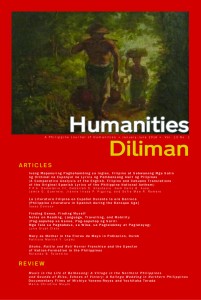 (JUNE 1)—The January to June 2016 issue of Humanities Diliman (HD Vol. 13, No.1) is now available online.
(JUNE 1)—The January to June 2016 issue of Humanities Diliman (HD Vol. 13, No.1) is now available online.
The official internationally-refereed journal of UP Diliman in the Arts and Letters cluster has five articles and one review.
The articles are: “Isang Mapanuring Paghahambing sa Ingles, Filipino, at Sebwanong Mga Salin ng Orihinal na Espanyol na Lyrics ng Pambansang Awit ng Pilipinas” by five authors (Deborrah S. Anastacio, Gem Carlo B. Ausa, Jamie G. Guerrero, Jianne Irissa P. Piguing, Sofia Mae R. Romero and F.P.A. Demeterio III); “La Literatura Filipina en Español Durante la era Barroca (Philippine Literature in Spanish during the Baroque Age)” by Isaac Donoso-Jiménez; “Mary as Mother in the Flores de Mayo in Poblacion, Oslob” by Patricia Marion Y. Lopez; “Finding Genoa, Finding Myself Notes on Reading, Language, Travelling, and Mobility (Pag-aapuhap sa Genoa, Pag-aapuhap ng Sarili Mga Tala sa Pagbabasa, sa Wika, sa Paglalakbay at Paglalayag)” by Luna Sicat Cleto; “Shake, Rattle and Roll Horror Franchise and the Specter of Nation-Formation in the Philippines” by Rolando B. Tolentino and “Music in the Life of Balbalasang: A Village in the Northern Philippines and Sounds of Bliss, Echoes of Victory: A Kalinga Wedding in Northern Philippines” by Maria Christine Muyco.
According to Editor-in-Chief Dr. Reuben Ramas Cañete, the current issue shows how the authors of five articles and one review “transpose their own knowledge production with their own subjectivities as scholars and advocates that envision knowledge through their particular lens of hermeneutics, positionality, and memory.”
The article “Isang Mapanuring Paghahambing sa Ingles, Filipino, at Sebwanong Mga Salin ng Orihinal na Espanyol na Lyrics ng Pambansang Awit ng Pilipinas” is about the translations made from Palma’s poem “Filipinas” that were used as the official lyrics of the Philippine national anthem.
Using a Likert Scale of Analysis, the five authors “tease out the relative distance of these translations from the original Spanish in terms of their actual textual meanings.” Cañete said the five authors’ comparative analysis of the English, Filipino and Cebuano translations of the original Spanish lyrics of the Philippine National Anthem “serves to establish a relative ‘distance of translation’ based on the theories of Freidrich Schleleiremacher.”
Donoso-Jiménez’s paper presents a comprehensive description of the Literature written in Spanish in the Philippine Archipelago from the 16th century to mid-18th century. He recaptures the works of Gaspar de san Agustin and the anonymous poets who wrote about the military exploits of Sebastian Hurtado de Corcuera (1637), and the untimely death of Prince Balthassar Carlos (1649).
Cañete said “By ‘re-stretching’ the concept of Filipino Literature away from an exclusively native viewpoint and back into its originally Spanish context (the literary works produced by Spaniards living in the Philippines), Donoso-Jiménez also returns this ‘neglected fragment’ back into the literary attention of Spain itself, along with (postcolonial) Filipinos who continue to manifest their cultural affinity for Spain and its languages.”
Lopez’s essay focuses on the study of Marian Flores de Mayo rituals in Oslob, Cebu and its meanings through examining Mary as a “semantically” open symbol. The author, according to Cañete “looks deeply at the complex ‘entanglement’ of meaning that results when a canonic Catholic text of the prayers associated with Mary as Mother of God and Virgin Most Pure collides and slides into the precolonial Bisaya folk world of enchanted spirits and intercessors, resulting in a terrain of contention between the “official” texts on Marian devotion produced and supervised by the town’s parish priest and the alternate meanings and suppressed voices of “unofficial” discourses produced by the Marian devotees themselves.”
Cleto’s essay recounts her personal experience in two languages, English and Filipino, as an exchange scholar in Genoa, Italy, under the Erasmus Mundi Mobility program. Cañete said the author “invest the resulting “autobiographical” texts with a naturally recurring rhythm of languages (English and Filipino) resulting from her own personal and academic background, which deploys a threefold reflection of her own nationalist orientation; her use of English as either academic medium or stopgap language between her native self and the foreigners around her; and her study of Italian as a requirement of her grant, a language to which she ties her own project of “translating her identity” using her study of the Italian poet Elsa Morante.”
Tolentino’s paper is an extensive study of the “Shake, Rattle, and Roll” movies, the most successful horror franchise in Philippine history, starting from 1984 to 2014. Cañete said the author’s subject “is utilized as referents to the ‘actual horror’ being existentially experienced by the nation at the same time as its iterations were being screened.”
In addition, the editor noted that Tolentino “also flags the industrial processes by which such successes were guaranteed: it featured the biggest stars of that year; established the reputations of new directors, screenwriters, sound editors, and cinematographers; and the steady migration from “art house” to commercial blockbuster film formats.”
Muyco reviews the documentary films of Michiyo Yoneno-Reyes and Yoshitaka Terada about the Kalinga peoples of Northern Luzon which according to Cañete “serves as a location point in which the critic’s own familiarity with ethnography and ethnomusicology comes into play.”
The study, Cañete said, correlated both silence and sound to the cultural character in the Kalinga “with their reputation for stoic village life in the everyday broken only by the sound of gongs, which denoted either the celebration of a wedding, or in the past, a victory celebration over the latest headhunting expedition.”
The printed version worth P325 is now available at the Office of the Vice Chancellor for Research and Development (OVCRD). For more information, please contact the OVCRD at (02) 981-8500 local 4048 or (02) 436-8720.
